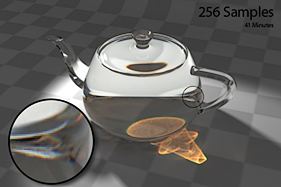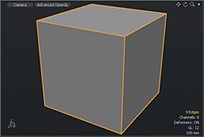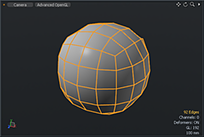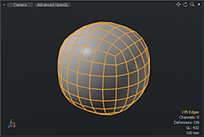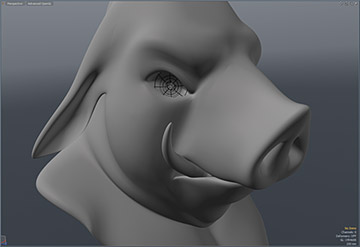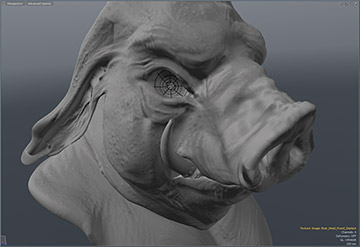Render Item: Default Renderer Settings
The Render item's Properties tab allows you to adjust render settings specific to rendering quality.
The following Render Item properties are available on the Settings tab for the Default renderer.
|
Option |
Description |
|---|---|
|
Apply Preset |
Allows you to create and save custom render settings as presets to reuse in other scenes.
• Store Preset • Remove Preset |
|
Renderer |
Choose between Modo's Default renderer and mPath. |
Legacy Renderer Options
Progressive Rendering Options
The following Render Item properties are available on the Progressive Rendering Options tab.
|
Option |
Description |
|
Convergence Target |
The Convergence Target option is used to set the rendering percentage value used by the Preview Viewport for progressive final rendering. The Preview Viewport output is based on the primary render output. The default value is set to 97.5%. Tip: You can also set this value by clicking the lock icon in the Preview Viewport, which is set to 100% as the default. For more information about Preview locking, see Preview Viewport. |
|
Max Render Time |
Specifies the rendering time to use when saving a frame to a disk. This option is used by Preview Viewport with the default option settings enabled and with the Render Animation option enabled. The time is specified in minutes and it can be set to less than a minute. For example, 0.5 equals half a minute. Tip: You can launch the progressive rendering window by clicking Rendering > Open Progressive Baking. |
Antialiasing
There are three main settings that control the quality of rendered pixels. These include Antialiasing, Refinement Shading Rate, and Refinement Threshold. To create the highest quality imagery, Modo does all of its computations at the sub-pixel level; taking multiple tiny samples, within the space of a single pixel, and then averaging their result. However, rather than computing the entire image this way, over and over (the "brute force" method), Modo uses elegant logic to determine how to best create the image. To balance quality with performance, Modo provides methods to determine which areas of the image should receive the greatest number of samples.
|
Option |
Description |
|---|---|
|
Antialiasing |
At the top-most level, the Antialiasing control dictates the number of samples taken per pixel. Modo allows you to specify from 1 to 1024 samples per pixel in powers of 2 (1, 2, 4, 8, 16, and so on, up to 1024). We can think of these samples as sub-pixel fragments, imagining a pixel as a square that can be divided into smaller squares. When Antialiasing is set to 8, the pixel is broken down into eight pieces, and each of these pieces is evaluated and then averaged together to give us the final high-quality pixel. Since it would be expensive time-wise to evaluate every single pixel in an image repeatedly, we have some additional controls to limit the areas that receive the maximum number of evaluations. Tip: The Antialiasing setting's effect is most apparent on geometric edges. A setting of 8 is generally acceptable, and is a good trade-off between quality and speed, though in reproducing effects, such as Depth of Field or Motion Blur, you need to increase this value, possibly up to 1024, to produce a pleasing result. |
|
Antialiasing Filter |
Allows you to choose different antialiasing filters. The Antialiasing Filter determines the pattern to use when evaluating a pixel. The default is Gaussian, which performs very well in most cases, and offers a good balance of performance and quality. Box, Triangle, Catmull-Rom, and Mitchell-Netravali are additional options. Catmull-Rom generally yields slightly sharper results than Gaussian, while Mitchell-Netravali offers good results when dealing with problematic moire (created by fine texture patterns). |
|
Frame Passes |
This controls how many times a single frame is rendered (not to be confused with Render Passes, which are entirely different). The results of each pass are evenly blended to make up the final frame. For example, the random numbers used to generate fur are varied for each pass, so the resulting blended fur looks softer. If motion blur is enabled, each frame pass covers just part of the exposure. If there are four frame passes, the first pass covers the first quarter of the interval from shutter open to shutter close. The random sampling for Depth of Field effect are also varied between passes, so additional passes help to smooth out troublesome soft focus. Increasing this value above 1 increases render times significantly, so unless you need softer fur or higher quality motion blur and depth of field, there is no added benefit to increasing this value.
|
|
Field Rendering |
Note: The Final Rendering option is hidden by default. Click the More button at the bottom of the panel to display all controls. For scanline televisions, there were originally two half frames that made up each whole frame, which were interlaced on top of each other to make a single image. Enabling the Field Rendering option properly renders two discreet moments in time and interlaces the resulting half-frames into a single image (in essence, doubling the frame rate). This option is useful to compose Modo-generated elements into video that was originally captured this way. Tip: When using Field Rendering, it's recommended that you switch to Box antialiasing to eliminate field cross-talking. Also, post effects, such as Bloom, are generated on a whole-image basis, so should only be applied in a compositing package. Modern film and video capture is largely progressive, where each frame represents only a single moment of time, so in most cases Field Rendering is not necessary. |
Shading Quality
The following Shading Quality options are available for the Render item:
|
Option |
Description |
||||||
|---|---|---|---|---|---|---|---|
|
Shading Rate |
Specifies the approximate spacing between shading samples, measured in pixels, used for the environment. It also acts as a cap on the rates specified in the various shader items, allowing shading detail to be increased across the entire frame. The main reason you might want to lower this value is to improve the motion blur of volumetrics. The default is 0.5. Lowering this increases shading sampling, smoothing out sharp reflections, shadows, and textures. |
||||||
|
Note: The Refinement Shading options are hidden by default. Click the More button at the bottom of the panel to display them. |
|||||||
|
Refinement Shading Rate |
Tells the engine how finely to evaluate any pixel that falls within the Refinement Threshold. When a pixel is being evaluated, first, it is rendered through the standard antialiasing application. Neighboring pixels are then tested for Refinement Threshold and, if a pixel is within the threshold, then the pixel is finished and the engine moves on to the next. If it's outside of the threshold, then the Refinement Shading Rate value kicks in, and the pixel is further evaluated. The value acts as a multiplier of the pixel's size, so a setting of 0.5 splits the pixel in half both ways, resulting in 4 additional shading samples calculated. A setting of 0.1 splits the pixel 10 times both directions, resulting in 100 additional shading samples calculated. The default value of 2.0 disables refinement shading. |
||||||
|
Refinement Threshold |
This control dictates how much contrast is acceptable between adjoining samples. Set to 100%, the Refinement Threshold does nothing at all, as it accepts brightness steps as high as 255 (the upper bound of a 24 bit image). At 0%, no pixels are inside the threshold, and every pixel is refined. The percent amount spans the 0 to 255 brightness steps, so a threshold of 50% accepts pixel contrasts of 128 steps, whereas a setting of 10% only tolerates 25 brightness steps between samples. Just like the refinement shading rate, we see that an increase in quality when set to lower values, but it also increases computation, requiring longer render times. |
||||||
|
Refine Bucket Borders |
Due to the "bucket" nature of Modo's render engine, adjacent pixels in neighboring render buckets can't be used to decide whether a border pixel needs further refinement, because they are either not rendered yet, or fully rendered and no longer active. By enabling Refine Bucket Border, Modo assumes that all border pixels in a given bucket require refinement. |
||||||
|
Reflection Depth |
Modo renders images by ray tracing, sort of like shooting tiny arrows out from the camera's lens and seeing what they hit. If a ray hits an object that is reflective, that ray bounces off the object until it hits another. Should that surface also be reflective Modo again bounces that ray until it finds a surface that is not reflective. If the ray doesn't find a surface that isn't reflective, the Reflection Depth threshold stops the ray from continuing on its path, keeping Modo from infinitely tracing rays between reflective surfaces. The default of 8 bounces is fine for most scenes, and is a good compromise between render accuracy (quality) and render time. In some instances, you may find a need to increase this setting to accurately portray all the reflective surfaces in a scene, or find you need to reduce it to shorten render times. |
||||||
|
Refraction Depth |
Like Reflection Depth, the refraction depth is calculated by ray tracing. When a ray enters a refractive surface with some transparency, the ray bends the appropriate amount and travels until it hits its next surface. If that surface is also refractive, again the ray is bent and sent along its path until it hits a non-refractive surface or is stopped by the Refraction Depth threshold from traveling further. The default setting of 8 is often good enough for most scenes, and is a good compromise between render accuracy (quality) and render time. In scenes with many transparent surfaces, you may find a need to increase the setting to accurately portray all your transparent surfaces, or find that you need to reduce it to shorten render times. |
||||||
|
Ray Threshold |
For some scenes, firing all those refraction and reflection rays can get expensive time-wise. Ray Threshold eliminates those rays that have little to no impact on the final rendered image. As rays are fired, they are given an importance value that can decrease or increase at each bounce, depending on the surface values contribution. Should the rays' importance fall below the Ray Threshold, Modo decides whether to kill the ray or trace it further (up until the total depth value specified). The killing of rays reduces the overall number and depth of rays traced, but has little visual impact on the final image. Increasing the Ray Threshold value further eliminates rays, though at the expense of image quality. |
||||||
|
Maximum Radiance |
Controls the maximum radiance carried by secondary rays. This can be helpful in reducing noise and preventing fireflies (single bright pixels) caused by small but very bright features of a scene, such as tight specular highlights or surfaces very close to point light sources. It acts as a multiplier for the most highly-exposed render output in the scene. Setting the Maximum Radiance to 10.0 (the default value) means that a ray is ten times brighter than the brightest render output. Note: This option doesn't clamp primary rays (anything seen directly by the camera). |
||||||
|
Boost Importance |
|
||||||
|
Reflection Samples |
A global setting used as a multiplier of the Base Material Properties > Material Trans tab, Subsurface Scattering > Subsurface Amount value and of the Base Material Properties > Material Rays tab, Ray Tracing > Importance value. Setting this parameter to 0 enables the Reflection Rays option for each Material item. For more information, on Reflection Rays, see Material Ref - Diffuse and Specular. |
||||||
|
Refraction |
A global setting used to edit the refraction level for all materials at once. If this setting is set to 0, the material settings are used instead. Refraction specifies the number of rays Modo uses to calculate the material property Refraction Roughness setting. As the roughness amount grows, the number of rays necessary to produce a smooth effect increases, at the expense of longer render times. Note: A rough surface does not necessarily need more samples than a sharp surface. During the rendering of the Refraction value higher than 0, the setting is multiplied by the Importance value, which measures how much a particular shading calculation can affect the final pixel color. For example, if the Reflection Samples is set to 64 but the material being shaded is only 50% reflective, only 32 rays are fired to compute a blurry reflection. Using Importance in this way, allows a single Reflection Samples value to adapt to a variety of materials. For information about the Material Ray Tracing > Importance option, see Material. |
||||||
|
Subsurface |
A global setting that determines the contribution of diffuse shading. This option uses the Subsurface Amount percentage value to determine the contribution of diffuse shading made by subsurface scattering. For more information about Subsurface Amount, see Material. |
||||||
|
Spectral Samples |
When rendering any transparent refractive surfaces with Dispersion, the Spectral Samples value determines the number of rays that each dispersion ray is broken into. The higher the number of rays, the smoother the dispersion calculations are, at the expense of longer render times.
|
||||||
|
Indirect Samples |
Note: The Indirect Samples option is only available when Indirect Illumination is enabled in the Global Illumination tab. See Indirect Illumination for more information. This value represents the number of samples taken for each pixel in the image when using the Monte Carlo indirect illumination model (irradiance caching disabled). Increasing this value results in higher quality at the expense of longer render times. |
||||||
|
Environment |
Note: The Environment option is only available when Environment Importance Sampling is enabled in the Global Illumination tab. See Environment Importance Sampling for more information. Determines the number of samples taken of the environment used for global illumination. More detailed environments benefit from additional samples, increasing the accuracy of the final render, but also increasing render time. On low resolution or low detail environments, you can keep this value low to reduce render time. |
||||||
|
Irradiance Samples |
Note: The Irradiance Samples option is only available when Irradiance Caching is enabled in the Global Illumination tab. See Irradiance Caching for more information. This option determines the number of Irradiance rays. |
||||||
Direct Lighting Options
The following Direct Lighting options are available for the Render item:
|
Option |
Description |
|---|---|
|
Direct Light Samples |
Modo uses an adaptive light sampling method that takes into account various attributes from direct light sources, such as their brightness, relative position to the shaded surface, and their intensity falloff, among other settings. These values combine to generate an overall importance amount for each light in a given scene, while still producing an unbiased result. Generally speaking, this method of working renders faster and produces higher quality shading, especially in scenes with many light sources, allowing the render engine to focus its sampling on only those lights that are most important. The main benefit being that light (and shadow) quality can be controlled by a single global setting rather than adjusting a Samples value per light, as done in earlier versions, simplifying the overall rendering process. The Light Samples value represents the total number of samples generated for all lights in a given scene. Shading noise can be decreased or eliminated by increasing this value, in exchange for longer render times. The higher the value, the smoother the shaded result. Common input values are available under the Value Preset pop-up. To disable adaptive light sampling, set this value to '0'. This, in turn, enables the Samples value per light, and works as in previous versions. In rare cases, there may be situations where individual lights don't produce the desired results. In these cases, a light's Importance setting can be increased or decreased depending on the desired outcome, acting as a multiplier to its evaluated importance. This setting is found under each light's Properties panel when selected. |
|
MIS |
Note: The MIS option is hidden by default. Click the More button at the bottom of the panel to display it. MIS stands for Multiple Importance Sampling and is a way of intelligently sampling direct lighting for both specular and diffuse shading, greatly reducing noise without a significant increase in render time. For most cases, the MIS default setting of Both produces the best results. In rare cases, you may wish to limit the MIS calculations to just the Specular shading or just to Diffuse shading. Setting MIS to None disables Multiple Importance Sampling, reverting to the legacy sampling method. It should be noted that MIS works with all shading models for diffuse shading, but MIS specular shading only works on the Energy Conserving and Physically Based models when Match Specular and Blurry Reflections are enabled for reflection shading. |
|
Shadows |
Enabled by default, the Shadows checkbox directs Modo to globally render all shadows cast by direct lights. Direct lights can be any of the light items, such as Distant Lights, Area Lights, Point Lights, Spot Lights, Dome Lights, Cylinder Lights, and Photometric Lights. Shadows cast by luminous polygons when Global Illumination is enabled are not affected by this setting (their shading is part of the indirect illumination). Shadows can also be disabled on a per-light basis in each light's properties panel, by setting shadow type to none. |
Geometry Options
The following Geometry options are available for the Render item:
The first two settings under the Geometry section are global controllers that relate to Subdivision Surface (SDS) models in a scene. Subdivision Surfaces is a means of producing a smooth, continuous mesh at render time, based on a low resolution proxy model (sometimes called the "cage" or Limit Surface). Generally, when straight polygon modeling, surfaces are made from faces - each its own tiny flat plane that, when shaded together, simulates a smooth surface - but silhouette edges can reveal the faceted nature of the model. The traditional fix for this limitation is to simply add more polygons, but controlling all those real polygons can quickly become unwieldy. For a SDS model, the polygons in the low resolution model are automatically divided and refined recursively in such a way that the resulting model is a smooth organically curving surface.
In Modo, you can toggle any object as an SDS model by simply pressing the Tab key. You can control the level (number of times the models is subdivided) using the Subdivision Level setting found in the Mesh Item properties viewport. Higher values produce smoother models, but generate more geometry that requires more processing time and memory to render. When the Adaptive Subdivision setting is enabled, this function overrides the Mesh Item setting at render time allowing you to adaptively control all the Subdivision Surfaces in a scene globally.
|
|
|
|
|
|
Original 'Cage' Geometry |
SubD level of 1 |
SubD level of 2 |
SubD level of 3 |
|
Option |
Description |
|---|---|
|
Adaptive Subdivision |
Toggles the Adaptive Subdivision function in Modo. When enabled, Modo adaptively tessellates all SDS meshes at render time. Which is to say, depending on the user settings, the mesh is refined repeatedly until all polygonal edges fall within the set subdivision rate. |
|
Subdivision Rate |
When Adaptive Subdivision is enabled, the subdivision rate sets the level threshold for all SDS geometry in a scene. Defined as pixels, the default rate is 10, which means that Modo picks a subdivision level for that mesh, such that the length of edges for any group polygons in the largest subdivision patch appear no more than 10 pixels long (most are shorter than that). This is very useful since it means that subdivision levels automatically adapt to each mesh's distance from the camera, the zoom factor, and similar. If you really want to minimize your polygon count, you can set the subdivision rate to a huge number such as 1000. On the other hand, if you never want to see a faceted edge in a render you can reduce this number to 5 or less. Be warned that reducing the subdivision rate comes at the expense of additional system memory use and performance loss. |
The next five settings control Modo's Micropolygon Displacement function: a means of adding fine geometric detail to surfaces by way of a texture-based controller. Similar in nature to Subdivision Surfaces, polygonal surfaces are automatically divided and refined recursively producing finer and finer micropolygons, which are then displaced (pushed in or out in the polygons normal direction) based on a grayscale value (and user settings in the Texture Locator item).
This can result in an incredible amount of detail for models that would be difficult or impossible to create otherwise. This is similar to a bump map, but where a bump map is a rendering trick that simulates detail on a surface and often looks imperfect, displacement is actual geometry. Displacement maps can be created in Modo, using any of the painting or sculpting tools, generated in an external application and applied to the object, or simply applied as a procedural texture layer in the Shader Tree. For best results, you should enable SDS for any surfaces with displacement applied. Please refer to the Effect - Texture Item topic for more information on working with displacement maps.
|
|
|
|
SDS Limit Surface |
Displacement Map applie |
|
Option |
Description |
|---|---|
|
Micropoly Displacement |
When an object's surface has displacement applied in the Shader Tree, this checkbox toggles the rendering of micropolygon displacement on a global level. |
|
Displacement Rate |
When Micropoly Displacement is enabled, the Displacement Rate, sets the threshold to which the geometry is subdivided into micropolygons. Similar to the Subdivision Rate, micropolygon displacement is adaptive, evaluating every polygon edge separately. The distance from the camera to the center of the edge (the focal length), and the render resolution are used to convert the Displacement Rate (in pixels) into a distance in world space. If the edge is longer than this and also longer than the Minimum Edge Length, it is split in half. This process continues recursively until all edges satisfy those requirements. |
|
Displacement Ratio |
Note: The Displacement Ratio option is hidden by default. Click the More button at the bottom of the panel to display all controls. When set to 1.0, objects are tessellated a consistent amount across their entire surface, but when displacing large areas, such as a ground plane in an environment, where a good deal of the geometry lays outside of the view of the camera, most of those polygons are going to waste, filling up your system's memory. The Displacement Ratio reduces the number of displaced polygons outside the camera's view. The higher the number, the greater the reduction in polygons. Keep in mind though that reflective and refractive objects still are able to see these areas outside the camera's view, so high settings may begin to introduce artifacts to your image. |
|
Minimum Edge Length |
Note: The Minimum Edge Length option is hidden by default. Click the More button at the bottom of the panel to display all controls. Each edge in the mesh is tessellated until polygons satisfy the Displacement Rate setting. Ungoverned, this can go out of control resulting in ridiculous numbers of polygons. The Minimum Edge Length sets a minimum length for any polygonal edge. Once an edge has reached that minimum length it can no longer be split. A simple and effective throttle for controlling the amount of polygons in your scene. |
|
Smooth Positions |
Note: The Smooth Positions checkbox is hidden by default. Click the More button at the bottom of the panel to display all controls. When a surface is diced into micropolygons, the initial positions of the micropolygon vertices lie on a curved surface based on the original smooth vertex normals. So, if you start with a regular non-SDS sphere, for example, it'll be diced into a smooth sphere, and then the displacement texture is applied to that. You could even use this as an alternative to subdivision surfaces by just applying a displacement texture that is zero everywhere (although the resulting surfaces are different from SDS in that they actually pass through the original vertices). The ability to turn off position smoothing, which means that all the initial positions of the micropolygon vertices lie exactly on the flat planes of the original polygons. Doing this in the non-subdiv sphere example would cause the diced version to look faceted. The reason this feature was added was that it's necessary to turn off position smoothing when using a displacement map created by object-to-object baking, since the distances in the map are measured based on the original polygons of the low-poly object and not the smoothed polygons. |
|
Displacement as Bump |
Note: The Displacement as Bump checkbox is hidden by default. Click the More button at the bottom of the panel to display all controls. When this option is enabled, Modo also applies any displacement maps as a bump map, providing a finer detail evaluation that requires lower number of subdivisions to achieve. This can be a great way to reduce the amount of memory necessary to render complex scenes when combined with lower subdivision rates. |
|
Indirect LOD |
Note: The Indirect LOD checkbox is hidden by default. Click the More button at the bottom of the panel to display all controls. When this option is enabled, Modo holds an additional lower resolution version of displaced geometry used strictly in calculating indirect lighting, reducing overhead in GI calculation. However, it may end up using slightly more memory as two distinct copies of the same geometry may be held in memory simultaneously. |
| Render Output Masking |



